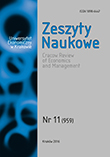Organising the Training Process in Polish Companies Operating on International Markets
DOI:
https://doi.org/10.15678/ZNUEK.2016.0959.1101Słowa kluczowe:
szkolenia, przedsiębiorstwa międzynarodowe, kapitał ludzki, zdolności organizacyjne, rozwój organizacjiAbstrakt
Tytuł artykułu: Organizacja procesu szkoleniowego w polskich firmach działających na rynkach międzynarodowych
Szkolenia są procesem umożliwiającym pracownikom rozwój zarówno ogólnych, jak i specyficznych dla każdej firmy kompetencji. W przedsiębiorstwach działających na rynkach międzynarodowych takie szkolenia zapewniają także transfer najlepszych praktyk, procedur i standardów działania z firmy macierzystej do filii. Osiąganie celów szkoleniowych wymaga więc, by proces doskonalenia kompetencji pracowników był zaprojektowany i realizowany w sposób profesjonalny, co dla firm działających na homogenicznych rynkach nie stanowi zbyt dużego wyzwania. Internacjonalizacja powoduje jednak, że organizowanie procesów personalnych wymaga uwzględnienia dodatkowych czynników związanych z różnorodnością, co może ograniczyć efektywność realizowanych dotychczas inicjatyw. W artykule wskazano na znaczenie procesu szkoleniowego w doskonaleniu kompetencji pracowników firm działających na rynkach międzynarodowych oraz zaprezentowano wyniki badań przeprowadzonych na grupie 50 polskich przedsiębiorstw działających na rynkach międzynarodowych. Celem tych badań była ocena stopnia profesjonalizacji działalności szkoleniowej oraz porównanie stosowanych praktyk do wytycznych ujętych w People Capability Maturity Model.
Downloads
Bibliografia
Adizes I. (2004), Managing Corporate Lifecycles, Adizes Institute Publications, Carpinteria.
Barney J.B. (1991), Firm Resources and Sustained Competitive Advantage, “Journal of Management”, vol. 17, no 1, https://doi.org/10.1177/014920639101700108.
Barrett A., O’Connell P.J. (2001), Does Training Generally Work? The Returns to in Company Training, “Industrial and Labor Relations Review”, vol. 54, no 3, https://doi.org/10.1177/001979390105400307.
Becker G.S. (1962), Investment in Human Capital: A Theoretical Analysis, “The Journal of Political Economy”, vol. 70, no 5, https://doi.org/10.1086/258724.
Bee F., Bee R. (1994), Training Needs Analysis and Evaluation, Institute of Personnel Management, London.
Boydell T., Leary M. (1996), Identifying Training Needs, Chartered Institute of Personnel Development, London.
Chiva R., Ghauri P., Alegre J. (2013), Organizational Learning, Innovation and Internationalization: A Complex System Model, “British Journal of Management”, vol. 25, no 4, https://doi.org/10.1111/1467-8551.12026.
Churchil N.C., Lewis V.L. (1983), The Five Stages of Small Business Growth, “Harvard Business Review”, vol. 61, no 3.
Curtis B., Hefley B., Miller S. (2009), People Capability Maturity Model Version 2.0, Carnegie Mellon University, https://www.sei.cmu.edu/reports/09tr003.pdf (accessed: 1.09.2016).
Eisenhardt K.M., Martin J.A. (2000), Dynamic Capabilities: What Are They, “Strategic Management Journal”, vol. 21, no 10–11, https://doi.org/10.1002/1097-0266(200010/11)21:10/11<1105::aid-smj133>3.0.co;2-e.
Flamholtz E.G., Randle Y. (2007), Successful Organizational Development and Growing Pains, Management Online Review, http://wfgcoyo.mgtsystems.com/sites/default/files/Successful%20Organizational%20Development%20and%20Growing%20Pains.pdf (accessed: 1.09.2016).
Galbreath J. (2005), Which Resources Matter the Most to Firm Success? An Exploratory Study of Resource-based Theory, “Technovation”, vol. 25, no 9, https://doi.org/10.1016/j.technovation.2004.02.008.
Grant R.M. (1996), Toward a Knowledge-based Theory of the Firm, “Strategic Management Journal”, vol. 17, no S2, https://doi.org/10.1002/smj.4250171110.
Greiner L.E. (1998), Evolution and Revolution as Organizations Growth, “Harvard Business Review”, May–June.
Hammer M. (2007), The Process Audit, “Harvard Business Review”, April.
Hanks S., Watson C., Jansen E., Chandler G. (1993), Tightening the Life-cycle Construct: A Taxonomic Study of Growth Stage Configurations in High-technology Organisations, “Entrepreneurship Theory and Practice”, vol. 18, no 2.
Hatch N.W., Dyer J.H. (2004), Human Capital and Learning as a Source of Sustainable Competitive Advantage, “Strategic Management Journal”, vol. 25, no 12, https://doi.org/10.1002/smj.421.
Johanson J., Vahlne J-E. (1990), The Mechanism of Internationalization, “International Marketing Review”, vol. 7, no 4.
Kirkpatrick D.L. (2007), Implementing the Four Levels: A Practical Guide for Effective Evaluation of Training Programs, Berrett-Koehler Publishers, San Francisco.
Kwon K., Rupp D.E. (2013), High-performer Turnover and Firm Performance: The Moderating Role of Human Capital Investment and Firm Reputation, “Journal of Organizational Behaviour”, vol. 34, no 1, https://doi.org/10.1002/job.1804.
Lepak D.P., Snell S.A. (1999), The Human Resource Architecture: Toward a Theory of Human Capital Allocation and Development, “The Academy of Management Review”, vol. 24, no 1, https://doi.org/10.2307/259035.
Liu W. (2004), The Cross-national Transfer of HRM Practices in MNCs: An Integrative Research Model, “International Journal of Manpower”, vol. 25, no 6, https://doi.org/10.1108/01437720410560415 .
Moumita N., Zaman L. (2013), An Analysis of Global Training and Experience Sharing in Multinational, “American Journal of Business and Management”, vol. 2, no 1, https://doi.org/10.11634/216796061302297.
Nikandrou I., Apospori E., Papalexandris N. (2008), Organisational Training and Development in the European Context: A Longitudinal Comparative Study among 18 European Countries, “European Journal of International Management”, vol. 2, no 3, https://doi.org/10.1504/ejim.2008.019699.
Pauli U. (2015), Rozwój pracowników (in:) Zarządzanie zasobami ludzkimi na rynkach międzynarodowych, ed. A. Pocztowski, Oficyna a Wolter Kluwer Business, Warszawa.
Pike S., Roos G., Marr B. (2005), Strategic Management of Intangible Assets and Value Drivers in R&D Organisations, “R&D Management”, vol. 35, no 2, https://doi.org/10.1111/j.1467-9310.2005.00377.x.
Pittiglio R., Sica E., Villa S. (2013), Innovation and Internationalization: The Case of Italy, “The Journal of Technology Transfer”, vol. 34, no 6, https://doi.org/10.1007/s10961-009-9107-5.
Pocztowski A. (2003), Kapitał intelektualny a zarządzanie zasobami ludzkimi, „Zeszyty Naukowe Akademii Ekonomicznej w Krakowie”, no 629.
Pocztowski A. (2007), Zarządzanie zasobami ludzkimi, PWE, Warszawa.
Quinn R.E., Cameron K. (1983), Organizational Life Cycles and Shifting Criteria of Effectiveness: Some Preliminary Evidence, “Management Science”, vol. 29, no 1, https://doi.org/10.1287/mnsc.29.1.33.
Schultz T.W. (1961), Investment in Human Capital, “The American Economic Review”, vol. 51, no 1.
Scott M., Bruce R. (1987), Five Stages of Growth in Small Business, “Long Range Planning”, vol. 20, no 3, https://doi.org/10.1016/0024-6301(87)90071-9.
Shaw J.D., Park T-Y., Kim E. (2013), A Resource-based Perspective on Human Capital Losses, HRM Investments, and Organizational Performance, “Strategic Management Journal”, vol. 34, no 5, https://doi.org/10.1002/smj.2025.
Simon H.A. (1991), Bounded Rationality and Organizational Learning, “Organization Science”, vol. 2, no 1, https://doi.org/10.1287/orsc.2.1.125.
Szulanski G. (1996), Exploring Internal Stickiness: Impediments to the Transfer of Best Practice within the Firm, “Strategic Management Journal”, vol. 17, no S2, https://doi.org/10.1002/smj.4250171105.
Valle R., Martin F., Romero P.M., Dolan S.L. (2000), Business Strategy, Work Process and Human Resource Training: Are They Congruent?, “Journal of Organizational Behaviour”, vol. 21, no 3, https://doi.org/10.1002/(sici)1099-1379(200005)21:3<283::aid-job16>3.0.co;2-c.




